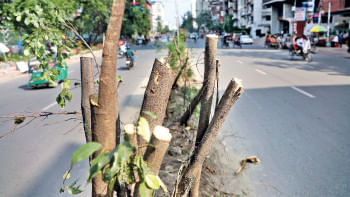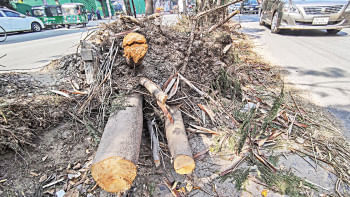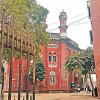DSCC tree-cutting: A development initiative or a murder spree?

When my husband and I took our first rickshaw ride to my office in Farmgate from our home in Rayerbazar sometime in May last year, we were pleasantly surprised by the rows of trees on Satmasjid Road, which served as a treat to our eyes and also made sure that we a had a natural green canopy protecting us from the harsh rays of the midday sun. In Dhaka, where greenery is always at peril, this stretch of road was a refreshing anomaly.
Fast forward to earlier this year. While returning home from work a little before midnight one night, I was shocked to see how some workers contracted by the Dhaka South City Corporation (DSCC) were mercilessly butchering the trees on the medians from Abahani field all the way to Jigatola. The felling stopped for a while owing to the Eid holidays, until recently when I found out that the DSCC had returned to chop down the last of the trees from Abahani field to Shankar. The trees are being cut down for a Tk 9.62 crore project initiated under the DSCC to develop different infrastructure and build public toilets, pavements, and walkways in the area.
DSCC Chief Engineer Saleh Ahmed said the city corporation planned to replace these plants with trees that are of higher quality. To reinforce the DSCC decision, the engineer further said the "geometric dimensions of the space require medians double the existing size" and assured that they have kept spots for plantation. According to other DSCC sources, the medians had to be widened and strengthened to prevent trees from falling down on the road causing accidents.
However, I wonder why the development project couldn't be carried out while preserving these trees. The most pressing question is: has this development project been designed with an environmentalist or an urban planner on board? If so, what exactly were their justifications behind this decision, and can they back it up with the latest research and experimentations from around the world?
According to a 2017 study published in the peer-reviewed journal PLOS One, an older tree absorbs and stores more carbon dioxide (CO2) than a younger tree as they are bigger in size. Also, as the CO2 is stored during a tree's food-making process, photosynthesis, the taller the tree, the more sunlight and carbon it is able to absorb. The study also suggested that replacing older mature trees with younger ones not only degrades the soil quality, but also impacts the new plant's overall quality and growth.
Bearing these facts in mind, it is expected to take at least another two decades for the newly planted trees to match the size and functionality of the felled ones, and this means that the residents of the area will have to wait for years to reap the same benefits as the trees that are being felled for this one carelessly planned project.
As for the project itself, the new medians – to my untrained eye – do not appear much bigger in size from the previous ones, and it surely does not seem it was doubled in size. Despite repeated attempts to reach the DSCC for the exact dimensions of the old and the existing medians, the officials could not be reached.
Over 300 trees that were originally planted to beautify this 900-metre-long road have been removed since the project's inception on September 20 last year.
Marina Nazneen, zonal executive officer (Zone-1) at the DSCC, said the trees that have been felled had very little environmental impact and were only planted to enhance the area's beauty. She also asserted the fact that no permission from the forest or environment departments was required to cut down trees for such projects, defying the Cabinet Division's rule that firmly states that seeking permissions from designated authorities is mandatory if one wishes to cut down any tree, even on a personal property.
A conversation with Munirul Islam, a division forest officer in Dhaka, on February 2 confirmed that no one from the DSCC had reached out to them seeking permission in this regard.
In contrast, the Dhaka North City Corporation (DNCC) recently took the initiative to appoint the first "chief heat officer" in Asia and promised to plant 200,000 trees in the next two years to help reduce the temperature of the city while purifying Dhaka's air. This is commendable, but only if the DNCC mayor manages to walk the talk.
It is also quite confusing as to how two ends of the same city are poles apart in their plans.
While multiple environmentalists have repeatedly expressed their worries over Dhaka's air quality, provided that the city steadily ranks as one of the top 10 cities with the most polluted air around the world, ruthlessly chopping down hundreds of trees in this metropolis and turning a blind eye to the matter may be convenient on their end, but it bothers me as a resident of the area.
Such initiatives compel me to think about my aged parents and the little children in my neighbourhood prone to falling sick frequently owing to the polluted air, and risking future health ailments such as lung cancer and chronic obstructive pulmonary disease.
The DSCC has decided to term this massacre "development" and "beautification," but for me, it was murder. Sadly, only a few sweat in protests to vouch for these green lives, while the rest choose to walk around Satmasjid Road, once a shaded green paradise for street dwellers but now a stack of concrete and cement, in silence.
Ashley Shoptorshi Samaddar is a sub-editor at the News Desk of The Daily Star.


 For all latest news, follow The Daily Star's Google News channel.
For all latest news, follow The Daily Star's Google News channel. 












Comments